Is a range-extended hybrid vehicle worth buying? What are its advantages and disadvantages compared to plug-in hybrid?
Let’s talk about plug-in hybrids first. The advantage is that the engine has a variety of driving modes, and it can maintain excellent efficiency regardless of the fuel-electricity state or different vehicle speeds. And with the engine participating in the drive, it can retain some of the experience of a traditional petrol car in terms of driving performance, driving feel, and even sound effects. In the past, plug-in hybrid vehicles had short pure electric range, difficult switching between gasoline and electricity, few opportunities for the engine to participate in direct drive, and high prices. But now it is basically not a problem. The battery life can basically reach the order of hundreds of kilometers. There are multiple levels of DHT assistance, the switching between oil and electricity is as smooth as silk, and the price has also dropped significantly.

Let’s talk about the extended-range formula. In the past, people used to like to say: “With electricity, you are a dragon, without electricity, you are a bug”, and “Without electricity, fuel consumption is higher than that of a fuel vehicle.” In fact, the new range extender does not have such a problem. It is also very efficient when running out of power. Compared with plug-in hybrids, it can accommodate larger batteries and stronger motors because it eliminates the need for a complicated oil-electric transmission structure. Therefore, it can be quieter and smoother, have a longer pure electric battery life, and is cheaper, with less worry and trouble in later maintenance.
So what should you pay attention to if you choose to add a program?
First, is its power consumption and fuel consumption high? This not only directly affects its economy, practicality and long-distance performance, but also represents the technical content of this range extension system.

The second is its performance. The range extender has a simple structure, with only two core parts: motor and battery. As I said just now, the range extender has a space advantage and can accommodate a larger battery. Don’t waste it. The mainstream of ordinary plug-in hybrids is about 20-degree batteries, which has a battery life of about 100 kilometers. But I think the range extender should at least have Only with a battery of 30 degrees or above and a pure electric range of 200 kilometers can its advantages be demonstrated, and only then can it make sense to abandon the plug-in hybrid and choose the extended-range model.
Finally, there is the price. Because the structure is simple and the technical content is not high, it also eliminates the development and production costs of the complex DHT petrol-electric transmission system. Therefore, the price of the extended-range model with the same configuration should be lower than that of the plug-in hybrid, or it should be competitive with the same level and the same price. Among the products, the configuration of the extended-range model should be higher than that of the plug-in hybrid, so that it can be considered cost-effective and worth buying.
Post time: May-28-2024


